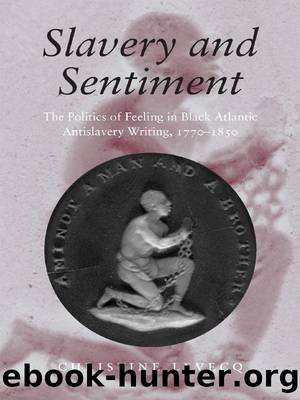Slavery and Sentiment by Christine Levecq

Author:Christine Levecq
Language: eng
Format: epub
Publisher: University Press of New England
John Marrant
John Marrantâs notion of brotherhood is caught in the turmoil of its liberal and republican implications. His political sensibility shows an interesting evolution from religious individualism to the budding republicanism of black Freemasonry, and his notion of brotherhood can be placed within this evolution. This development can be partly attributed to his transatlantic voyages and persona. Marrant was born in New York City in 1755, then moved to Florida, Georgia, and South Carolina. After several years in the Royal Navy, he was ordained a Methodist minister in England and published his Narrative there in 1785. He spent some time in Nova Scotia as a minister, then in Boston, and finally returned to England, where he published his Journal in 1790. He died the next year. In his writings Marrant makes few references to slavery, except for his fourth edition of the Narrative, as well as a few mentions of slavery in his sermons. But those references signal a philosophy in movement.
Marrantâs world of feeling was filled with religious faith, and as with Phillis Wheatley, this sensibility partly led to a focus on interiority. Marrant published the Narrative the year he was ordained in Bath by the Huntingdonian Connexion, a Methodist sect endowed by Selina Hastings, Countess of Huntingdon, also famous as the person to whom Wheatleyâs collection of poems and Gronniosawâs narrative were dedicated. The year he was ordained, Marrant left England and sailed to Nova Scotia, where a community of black loyalists had settled, hoping for land and economic independence. Once there, he established a church and a school in Birchtown, and also worked in the area as an itinerant preacher. He stayed there for a few years, and after a sojourn of several months in Boston, he sailed back to England, where he published his Journal, which records his experiences in Canada and Massachusetts, and died in April 1791. Unlike the Wesleyan Methodists, who were Arminian, the Huntingdonians believed in predestination. Joanna Brooks shows how Marrantâs Calvinism easily integrated what she presents as an essential trope of early African American literature, the motif of Lazarus. Based on John 11, in which Lazarus is raised from the dead by Jesus, this motif informs black texts with images of suffering and death followed by symbols of resurrection and regeneration.24 The images fit a black experience marked by suffering and loss, and by attempts to deal with that loss that are grounded in religious and biblical feeling. Marrantâs Journal was such an attempt: it emphasizes an ideology of conversion, salvation, and new birth.
But the Journal also shows a more communal dimension. Brooks highlights in Marrant what at the time may have seemed an old-fashioned idea, the notion of a covenant between God and the black community.25 According to Brooks, in Birchtown Marrant âpromulgated a powerful black Atlantic theology specific to the communityâs needs and experiences.â Part of this theology ârestored the abandoned Calvinist concept of the covenant community as a site of regeneration, and Marrant redeveloped this covenant theology for the black Atlantic.
Download
This site does not store any files on its server. We only index and link to content provided by other sites. Please contact the content providers to delete copyright contents if any and email us, we'll remove relevant links or contents immediately.
4 3 2 1: A Novel by Paul Auster(11788)
The handmaid's tale by Margaret Atwood(7447)
Giovanni's Room by James Baldwin(6808)
Asking the Right Questions: A Guide to Critical Thinking by M. Neil Browne & Stuart M. Keeley(5355)
Big Magic: Creative Living Beyond Fear by Elizabeth Gilbert(5351)
Ego Is the Enemy by Ryan Holiday(4956)
On Writing A Memoir of the Craft by Stephen King(4662)
The Body: A Guide for Occupants by Bill Bryson(4583)
Ken Follett - World without end by Ken Follett(4443)
Bluets by Maggie Nelson(4261)
Adulting by Kelly Williams Brown(4232)
Eat That Frog! by Brian Tracy(4149)
Guilty Pleasures by Laurell K Hamilton(4116)
White Noise - A Novel by Don DeLillo(3829)
The Poetry of Pablo Neruda by Pablo Neruda(3815)
Fingerprints of the Gods by Graham Hancock(3738)
Alive: The Story of the Andes Survivors by Piers Paul Read(3730)
The Book of Joy by Dalai Lama(3697)
The Bookshop by Penelope Fitzgerald(3619)
